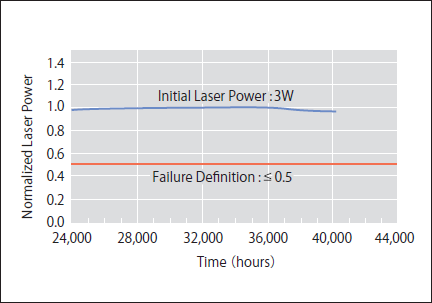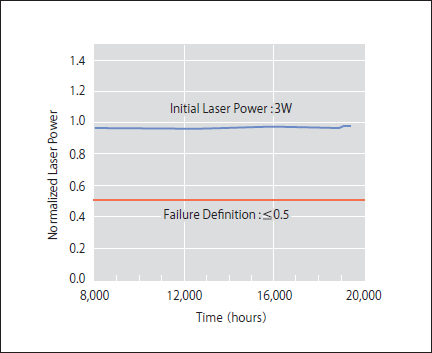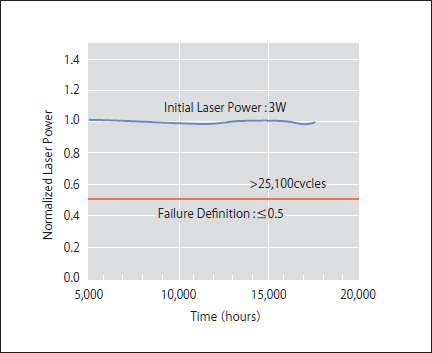光技術情報誌「ライトエッジ」No.39(2013年6月発行)
レーザーディスプレイ国際会議
(2012年4月)
Multi-Watt Class, Red, Green, and Blue, Direct Emitting and
Frequency Doubled Laser Diodes for Display Applications
Hidekazu Hatanaka1), Gregory T. Niven2)
1)SSLS Development Division, USHIO INC.,
1194, Sazuchi, Bessho-cho, Himeji, Hyogo 671-0224, Japan, +81-79-252-4318 (phone) -4626(fax)
h.hatanaka@ushio.co.jp 2)Necsel Intellectual Property
ABSTRACT
We provide multi-watt class red, green, and blue lasers as a solid state light source solution for projectors and other display applications. Life tests demonstrated over 38,500 hours of actual operation for green and blue lasers. The test for red laser has passed 7,000 hours under acceleration test condition and is going on.
1. INTRODUCTION
Solid state light source based on semiconductor technology has a lot of attractive properties as a light source for projectors1,2) such as long life and quick start. We provide multi-watt class red, green, and blue lasers as a solid state light source solution. The wavelengths of these red, green, and blue lasers are 639 nm, 532 nm, and 465 nm, respectively. The red (Model NECSEL-640-5000) is a direct-emitting laser diode with continuous wave output power of 5 W. Both green (Model NECSEL-532-3000) and blue (Model NECSEL-465-3000) are Necsel type laser diodes with output power of 3 W3,4). This paper reviews the technology used for these laser product s and di scus ses the reliability based on measured life test data.

Table.1 Specifications of Necsel red, green, and blue laser diodes
2. Laser structures and Life tests
This chapter reviews typical properties and life test results of each laser.
2.1 Green and blue lasers
Both green and blue are unique Necsel-type laser diodes with output power of 3 W shown in Fig. 1 [3,4].
The Necsel-type laser diode is an intra-cavity, frequency doubled type visible laser diode, which is composed with an infrared (IR) VCSEL (Vertical Cavity Surface Emitting Laser) array and a nonlinear optical crystal (PPLN:Periodically Poled Lithium Niobate) for blue of 465 nm and green of 532 nm. For both green and blue Necsel type laser diodes of the first generation, diamond was used as the submount material for excellent thermal conductivity. The life test result shown in Fig. 2 demonstrates that the laser output power is almost the same as the initial after 35,000 hours. This corresponds to over 10-year of use if it is used ten hours per day,seven days per week, and 50 weeks per year , which would be very typical for projection applications.
Generation 3 in Figs . 3 and 4 is the present product employing Cu-plated AlN as the submount material for matching of coefficients of thermal expansion with the GaAs die and copper cooling plate.
The life test result in Fig. 3 demonstrates that the laser output power is almost the same as the initial after 19,400 hours under the accelerated test condition of Tnecsel = 50°C, corresponding to 38,800 hours for the rated temperature of Tnecsel = 40 °C.
The on-off test result in Fig.4 demonstrates that the laser output power is almost the same as the initial for the third generation after over 25,000 on-off cycles. Thermal stress was applied to confirm the stable operation at a variety of installation sites. The initial laser power level was set at 3 W. The temperature of Tnecsel moved between 28 °C and 40 °C in one on-off cycle. Each on-off cycle has typically a 20-minute on-state to heat the laser by self-generating heat and a 20-minite off-state to cool the laser by forced air flow. The result shows that after over 25,000 on-off cycles, the laser output power is almost the same as the initial. This corresponds to over 14-year of use if these are used five times on-off per day, seven days per week, and 50 weeks per year, which would be very typical for cinema projection applications.

Fig.1 Necsel type green and blue lasers. (a) Schematic of the laser,
and (b) photo of green laser in operation.

Fig.2 Life test result of green laser (Gen.1).

Fig.3 Accelerated life test result of green laser (Gen.3).
Acceleration factor is two when Tnecsel = 50°C,
which is higher than the rating of 40 °C by 10 °C.

Fig.4 On-off test result of blue laser (Gen.3).
Test condition for one cycle is 20 minutes on and 20 minutes off typically.
2.2 Red laser
Fig.5 shows di rec t emitting LD; (a) with collimation lens option, and (b) with fiber coupling option.
Fig.6 demonstrated that the laser output power is stable over 7,000 hours after some decrease during initial hundreds hours under an output power acceleration test condition of 6 W which is higher than the rated 5 W by 1 W. The acceleration factor is not discussed concretely here. However, it looks very promising to operate the laser much longer time at the rating of 5 W.

Fig.5 Red laser diodes. (a) Collimation lens option,
and (b)Fiber coupling option.

Fig.6 Life test result of red laser diode. Test condition
for laser power of 6 W is higher than the rating of 5 W by 1 W.
3. Conclusions
The life tests demonstrated over 38,500 hours of actual operation for both green and blue laser diodes. The test for red laser has passed 7,000 hours under acceleration test condition and is going on. We believe these reliable lasers are suitable for light sources for projectors and other displays.
論文を探す
今号では、各種の光源(半導体露光用EUV、複写機用LED、高輝度・長寿命・高安定のLDLS、光加熱用ハロゲンヒータなど)や、光の装置・システム(インターポーザ基板用露光装置、スマートフォン・タブレット端末用UVキュア、新規蛍光免疫素子Q-bodyによる薬物検出システムなど)など、2012年春から2013年春にかけて発表した技術や市場動向の論文15件を掲載しました。
シリーズ「大学研究室を訪ねて」では、新しい機能性タンパク質と有機メソッドの創製に挑む、東京工業大学資源化学研究所の上田先生をお訪ねし、開発に成功され、今、話題を集めているQ-bodyを用いた免疫測定法をご紹介しております。
(2013年06月)


